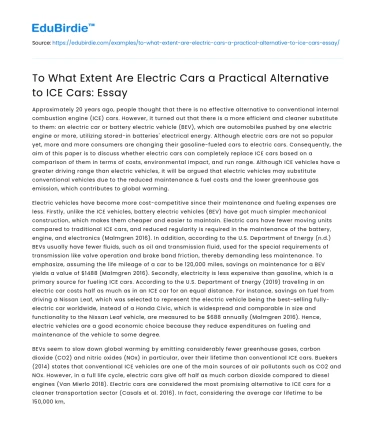Approximately 20 years ago, people thought that there is no effective alternative to conventional internal combustion engine (ICE) cars. However, it turned out that there is a more efficient and cleaner substitute to them: an electric car or battery electric vehicle (BEV), which are automobiles pushed by one electric engine or more, utilizing stored-in batteries' electrical energy. Although electric cars are not so popular yet, more and more consumers are changing their gasoline-fueled cars to electric cars. Consequently, the aim of this paper is to discuss whether electric cars can completely replace ICE cars based on a comparison of them in terms of costs, environmental impact, and run range. Although ICE vehicles have a greater driving range than electric vehicles, it will be argued that electric vehicles may substitute conventional vehicles due to the reduced maintenance & fuel costs and the lower greenhouse gas emission, which contributes to global warming.
Electric vehicles have become more cost-competitive since their maintenance and fueling expenses are less. Firstly, unlike the ICE vehicles, battery electric vehicles (BEV) have got much simpler mechanical construction, which makes them cheaper and easier to maintain. Electric cars have fewer moving units compared to traditional ICE cars, and reduced regularity is required in the maintenance of the battery, engine, and electronics (Malmgren 2016). In addition, according to the U.S. Department of Energy (n.d.) BEVs usually have fewer fluids, such as oil and transmission fluid, used for the special requirements of transmission like valve operation and brake band friction, thereby demanding less maintenance. To emphasize, assuming the life mileage of a car to be 120,000 miles, savings on maintenance for a BEV yields a value of $1488 (Malmgren 2016). Secondly, electricity is less expensive than gasoline, which is a primary source for fueling ICE cars. According to the U.S. Department of Energy (2019) traveling in an electric car costs half as much as in an ICE car for an equal distance. For instance, savings on fuel from driving a Nissan Leaf, which was selected to represent the electric vehicle being the best-selling fully-electric car worldwide, instead of a Honda Civic, which is widespread and comparable in size and functionality to the Nissan Leaf vehicle, are measured to be $688 annually (Malmgren 2016). Hence, electric vehicles are a good economic choice because they reduce expenditures on fueling and maintenance of the vehicle to some degree.
Save your time!
We can take care of your essay
- Proper editing and formatting
- Free revision, title page, and bibliography
- Flexible prices and money-back guarantee
BEVs seem to slow down global warming by emitting considerably fewer greenhouse gases, carbon dioxide (CO2) and nitric oxides (NOx) in particular, over their lifetime than conventional ICE cars. Buekers (2014) states that conventional ICE vehicles are one of the main sources of air pollutants such as CO2 and NOx. However, in a full life cycle, electric cars give off half as much carbon dioxide compared to diesel engines (Van Mierlo 2018). Electric cars are considered the most promising alternative to ICE cars for a cleaner transportation sector (Casals et al. 2016). In fact, considering the average car lifetime to be 150,000 km, electric cars are found to lessen global warming potential (GWP) by 20% to 24% compared to gasoline ICE cars and by 10% to 14% corresponding to diesel ICE cars (Hawkins 2012). In contrast to ICE cars, electric cars produce CO2 only during their manufacturing. According to the U.S. Environmental Protection Agency (2018), the median gasoline car on the road nowadays has a fuel economy of approximately 22.0 miles per gallon and its drive range is about 11,500 miles per year. Therefore, the average car over a year of driving has a tailpipe CO2 emissions of nearly 4.6 metric tons annually, whereas a car that works completely on electricity, an electric car, will not produce any tailpipe emissions. Equally important, ICE cars make a great impact on global warming by emitting significant amounts of nitric oxide. According to the European Environment Agency (2016), diesel engines are the largest contributor to NOx emissions, accounting for 46% of total NOx emissions in the European Union in 2013, while electric cars, again, do not emit any tailpipe gases. Thus, electric cars help to moderate ongoing global warming by significant reductions in the emission of greenhouse gases such as carbon dioxide and nitric oxides.
Despite the previously mentioned benefits, electric cars still possess some drawbacks. The small driving range indicates that ICE cars may be preferable in performance to electric cars, which on average have a shorter range than conventional cars. According to Van Mierlo (2018), the electric car has a much smaller drive range than a gasoline car, which is typically about 500 km. Whereas the typical electric cars are more in the range of 150 km. Similarly, according to the Plug-in Hybrid & Electric Vehicle (PH&EV), Research Centre (n.d.) most electric vehicles are nowadays capable of about 100 miles (approximately 161 km) of driving before they need to be recharged. Hence, the limited driving range is an aspect that an electric car still has to improve on.
In conclusion, electric cars may serve to some degree as an alternative to conventional cars nowadays. This paper has argued that electric cars are a more advantageous and economical choice and that it contributes to environmental protection. Firstly, reductions in maintaining and fueling costs were identified. Next, it was determined that CO2 and NOx greenhouse gases emission have been reduced. However, electric cars still can not completely substitute conventional cars. Limitation in drive range was discussed in this paper as well.






 Stuck on your essay?
Stuck on your essay?

